High-Resolution Reconstruction of Oxidation–Reduction Conditions: Raman Spectroscopy and μ-XRF Analysis of Manganese Nodule and Crust on Tabletop of Western Pacific Magellan Seamounts
Abstract
:1. Introduction
2. Materials and Methods
Samples
3. Data
3.1. Micro-Laser Raman Spectroscopy
3.2. Micro X-ray Fluorescence (μ-XRF)
3.3. Growth Rate and Age Dating of Fe-Mn Deposits Using a Co-Chronometer
4. Results
4.1. Morphology and Texture
4.1.1. Texture and Morphology of Fe-Mn Crust
4.1.2. Texture and Morphology of Fe-Mn Nodule
4.2. Geochemistry
4.2.1. Geochemistry of Fe-Mn Crust
4.2.2. Geochemistry of Fe-Mn Nodule
4.3. Mineralogy
4.3.1. Mineralogy of Fe-Mn Crust
4.3.2. Mineralogy of Fe-Mn Nodule
4.4. Growth Rate and Age Estimated by the Co-Chronometer
5. Discussion
5.1. Formation of Fe-Mn Deposit Minerals of OSM-XX
5.2. Paleo-Ocean Environment Recorded in the Fe-Mn Deposit Minerals of OSM-XX
5.2.1. Period Before Mid-Miocene Minor Phosphatization Event
5.2.2. Period After Mid-Miocene Minor Phosphatization Event
6. Conclusions
Author Contributions
Funding
Data Availability Statement
Conflicts of Interest
References
- Hein, J.R.; Mizell, K.; Koschinsky, A.; Conrad, T.A. Deep-ocean mineral deposits as a source of critical metals for high- and green-technology applications: Comparison with land-based resources. Ore Geol. Rev. 2013, 51, 1–14. [Google Scholar] [CrossRef]
- Glasby, G.P.; Ren, X.; Shi, X.; Pulyaeva, I.A. Co–rich Mn crusts from the Magellan Seamount cluster: The long journey through time. Geo-Mar. Lett. 2007, 27, 315–323. [Google Scholar] [CrossRef]
- Hein, J.R.; Koschinsky, A. Deep-Ocean Ferromanganese Crusts and Nodules. In Treatise on Geochemistry; Scott, S., Ed.; Elsevier: Amsterdam, The Netherlands, 2014; pp. 273–291. [Google Scholar] [CrossRef]
- Koschinsky, A.; Halbach, P. Sequential leaching of marine ferromanganese precipitates: Genetic implications. Geochim. Cosmochim. Acta 1995, 59, 5113–5132. [Google Scholar] [CrossRef]
- Halbach, P.; Puteanus, D. The influence of the carbonate dissolution rate on the growth and composition of Co-rich ferromanganese crusts from Central Pacific seamount areas. Earth Planet. Sci. Lett. 1984, 68, 73–87. [Google Scholar] [CrossRef]
- Hein, J.R.; Bohrson, W.A.; Schulz, M.S.; Noble, M.; Clague, D.A. Variations in the fine-scale composition of a Central Pacific ferromanganese crust: Paleoceanographic implications. Paleoceanography 1992, 7, 63–77. [Google Scholar] [CrossRef]
- Hyeong, K.; Kim, K.; Yoo, C.M.; Moon, J.W.; Kim, K.H. Phosphogensis recorded in the Co-rich crusts of the northwest Pacific seamounts. J. Geol. Soc. Korea 2008, 44, 435–446. [Google Scholar]
- Verlaan, P.A.; Cronan, D.S.; Morgan, C.L. A comparative analysis of compositional variations in and between marine ferromanganese nodules and crusts in the South Pacific and their environmental controls. Prog. Oceanogr. 2004, 63, 125–158. [Google Scholar] [CrossRef]
- Glasby, G.P. Manganese: Predominant role of nodules and crusts. In Marine Geochemistry; Springer: Berlin/Heidelberg, Germany, 2006; pp. 371–427. [Google Scholar]
- Dymond, J.M.; Lyle, B.; Finney, D.Z.; Piper, K.; Murphy, R.; Conard Pisias, N. Ferromanganese nodules from MANOP Sites H, S, and R—Control of mineralogical and chemical composition by multiple accretionary processes. Geochim. Cosmochim. Acta 1984, 48, 931–949. [Google Scholar] [CrossRef]
- Wegorzewski, A.V.; Kuhn, T. The influence of suboxic diagenesis on the formation of manganese nodules in the Clarion Clipperton nodule belt of the Pacific Ocean. Mar. Geol. 2014, 357, 123–138. [Google Scholar] [CrossRef]
- Park, J.; Jung, J.; Ko, Y.; Lee, Y.; Yang, K. Reconstruction of the Paleo-Ocean Environment Using Mineralogical and Geochemical Analyses of Mixed-Type Ferromanganese Nodules From the Tabletop of Western Pacific Magellan Seamount. Geochem. Geophys. Geosystems 2023, 24, e2022GC010768. [Google Scholar] [CrossRef]
- Burns, R.G.; Mee Burns, V. Mechanism for nucleation and growth of manganese nodules. Nature 1975, 255, 130–131. [Google Scholar] [CrossRef]
- Burns, V.M.; Burns, R.G. Observations of processes leading to the uptake of transition metals in manganese nodules. La Genèse Des Nodules De Manganèse 1979, 289, 387–404. [Google Scholar]
- Golden, D.; Chen, D.; Dixon, J. Synthesis of todorokite. Science 1986, 231, 717–719. [Google Scholar] [CrossRef]
- Manceau, A.; Combes, J. Structure of Mn and Fe oxides and oxyhydroxides: A topological approach by EXAFS. Phys. Chem. Miner. 1988, 15, 283–295. [Google Scholar] [CrossRef]
- Manceau, A.; Gorshkov, A.I.; Drits, V.A. Structural chemistry of Mn, Fe, Co, and Ni in manganese hydrous oxides: Part II. Information from EXAFS spectroscopy and electron and X-ray diffraction. Am. Mineral. 1992, 77, 1144–1157. [Google Scholar]
- Varentsov, I.M.; Drits, V.A.; Gorshkov, A.I.; Sivtsov, A.V.; Sakharov, B.A. Mn-Fe oxyhydroxide crusts from Krylov Seamount (eastern Atlantic): Mineralogy, geochemistry and genesis. Mar. Geol. 1991, 96, 53–70. [Google Scholar] [CrossRef]
- Takematsu, N.; Sato, Y.; Okabe, S. Factors controlling the chemical composition of marine manganese nodules and crusts: A review and synthesis. Mar. Chem. 1989, 26, 41–56. [Google Scholar] [CrossRef]
- Halbach, P. Processes controlling the heavy metal distribution in Pacific ferromanganese nodules and crusts. Geol. Rundsch. 1986, 75, 235–247. [Google Scholar] [CrossRef]
- Halbach, P.; Hebisch, U.; Scherhag, C. Geochemical variations of ferromanganese nodules and crusts from different provinces of the Pacific Ocean and their genetic control. Chem. Geol. 1981, 34, 3–17. [Google Scholar] [CrossRef]
- Halbach, P.; Scherhag, C.; Hebisch, U.; Marchig, V. Geochemical and mineralogical control of different genetic types of deep-sea nodules from the Pacific Ocean. Miner. Depos. 1981, 16, 59–84. [Google Scholar] [CrossRef]
- Manceau, A.; Lanson, M.; Takahashi, Y. Mineralogy and crystal chemistry of Mn, Fe, Co, Ni, and Cu in a deep-sea Pacific polymetallic nodule. Am. Mineral. 2014, 99, 2068–2083. [Google Scholar] [CrossRef]
- Lei, G.; Boström, K. Mineralogical control on transition metal distributions in marine manganese nodules. Mar. Geol. 1995, 123, 253–261. [Google Scholar] [CrossRef]
- Yang, K.; Park, H.; Son, S.K.; Baik, H.; Park, K.; Kim, J.; Yoon, J.; Park, C.H.; Kim, K. Electron microscopy study on the formation of ferromanganese crusts, western Pacific Magellan Seamounts. Mar. Geol. 2019, 410, 32–41. [Google Scholar] [CrossRef]
- Benites, M.; Millo, C.; Hein, J.; Nath, B.N.; Murton, B.; Galante, D.; Jovane, L. Integrated Geochemical and Morphological Data Provide Insights into the Genesis of Ferromanganese Nodules. Minerals 2018, 8, 488. [Google Scholar] [CrossRef]
- Bu, W.; Shi, X.; Peng, J.; Qi, L.i. Geochemical characteristics of seamount ferromanganese nodules from mid-Pacific Ocean. Chin. Sci. Bull. 2003, 48, 98–105. [Google Scholar] [CrossRef]
- Machida, S.; Nakamura, K.; Kogiso, T.; Shimomura, R.; Horinouchi, K.; Okino, K.; Kato, Y. Fine-scale chemostratigraphy of cross-sectioned hydrogenous ferromanganese nodules from the western North Pacific. Isl. Arc 2021, 30, e12395. [Google Scholar] [CrossRef]
- Halbach, P.; Segl, M.; Puteanus, D.; Mangini, A. Co-fluxes and growth rates in ferromanganese deposits from central Pacific seamount areas. Nature 1983, 304, 716–719. [Google Scholar] [CrossRef]
- Jeong, K.; Jung, H.; Kang, J.; Morgan, C.; Hein, J. Formation of ferromanganese crusts on northwest intertropical Pacific seamounts: Electron photomicrography and microprobe chemistry. Mar. Geol. 2000, 162, 541–559. [Google Scholar] [CrossRef]
- Segl, M.; Mangini, A.; Beer, J.; Bonani, G.; Suter, M.; Wölfli, W. Growth rate variations of manganese nodules and crusts induced by paleoceanographic events. Paleoceanography 1989, 4, 511–530. [Google Scholar] [CrossRef]
- Segl, M.; Mangini, A.; Bonani, G.; Hofmann, H.; Nessi, M.; Suter, M.; Wölfli, W.; Friedrich, G.; Plüger, W.; Wiechowski, A. 10Be-dating of a manganese crust from Central North Pacific and implications for ocean palaeocirculation. Nature 1984, 309, 540–543. [Google Scholar] [CrossRef]
- Wojdyr, M. Fityk: A general-purpose peak fitting program. J. Appl. Crystallogr. 2010, 43, 1126–1128. [Google Scholar] [CrossRef]
- Bernardini, S.; Della Ventura, G.; Sodo, A.; Benites, M.; Jovane, L.; Hein, J.R.; Lucci, F. Micro-Raman mapping of critical metals (Li, Co, Ni) in a rhythmically laminated deep-ocean ferromanganese deposit. Geochemistry 2024, 84, 126014. [Google Scholar] [CrossRef]
- Puteanus, D.; Halbach, P. Correlation of Co concentration and growth rate—A method for age determination of ferromanganese crusts. Chem. Geol. 1988, 69, 73–85. [Google Scholar] [CrossRef]
- Manheim, F.; Lane-Bostwick, C. Cobalt in ferromanganese crusts as a monitor of hydrothermal discharge on the Pacific sea floor. Nature 1988, 335, 59–62. [Google Scholar] [CrossRef]
- Post, J.E.; McKeown, D.A.; Heaney, P.J. Raman spectroscopy study of manganese oxides: Layer structures. Am. Mineral. 2021, 106, 351–366. [Google Scholar] [CrossRef]
- Kim, H.I.; Cho, H.G.; Lee, S.; Koo, H.J.; Hong, J.K.; Jin, Y.K. Spatial distribution of manganese oxide minerals in the natural ferromanganese nodule of the Arctic Sea: A view from Raman spectroscopy. Chem. Geol. 2023, 623, 121398. [Google Scholar] [CrossRef]
- Post, J.E.; McKeown, D.A.; Heaney, P.J. Raman spectroscopy study of manganese oxides: Tunnel structures. Am. Mineral. 2020, 105, 1175–1190. [Google Scholar] [CrossRef]
- Kim, J.; Hyeong, K.; Jung, H.S.; Moon, J.W.; Kim, K.H.; Lee, L. Southward shift of the Intertropical Convergence Zone in the western Pacific during the late Tertiary: Evidence from ferromanganese crusts on seamounts west of the Marshall Islands. Paleoceanography 2006, 21. [Google Scholar] [CrossRef]
- Park, J.; Yang, K. Revealing the Paleo-ocean Environment of OSM-XX in the Western Pacific Magellan Seamount with Mineralogical and Geochemical Properties of Ferromanganese Crust. Econ. Environ. Geol. 2023, 56, 55–63. [Google Scholar] [CrossRef]
- Hodkinson, R.; Cronan, D. Regional and depth variability in the composition of cobalt-rich ferromanganese crusts from the SOPAC area and adjacent parts of the central equatorial Pacific. Mar. Geol. 1991, 98, 437–447. [Google Scholar] [CrossRef]
- McMurtry, G.; VonderHaar, D.; Eisenhauer, A.; Mahoney, J.; Yeh, H.W. Cenozoic accumulation history of a Pacific ferromanganese crust. Earth Planet. Sci. Lett. 1994, 125, 105–118. [Google Scholar] [CrossRef]
- Zachos, J.; Pagani, M.; Sloan, L.; Thomas, E.; Billups, K. Trends, rhythms, and aberrations in global climate 65 Ma to present. Science 2001, 292, 686–693. [Google Scholar] [CrossRef] [PubMed]
- Haq, B.U.; Hardenbol JA, N.; Vail, P.R. Chronology of fluctuating sea levels since the Triassic. Science 1987, 235, 1156–1167. [Google Scholar] [CrossRef]
- Benites, M.; Hein, J.R.; Mizell, K.; Blackburn, T.; Jovane, L. Genesis and evolution of ferromanganese crusts from the summit of Rio Grande Rise, Southwest Atlantic Ocean. Minerals 2020, 10, 349. [Google Scholar] [CrossRef]
- Benites, M.; Hein, J.R.; Mizell, K.; Jovane, L. Miocene phosphatization of rocks from the summit of Rio Grande Rise, Southwest Atlantic Ocean. Paleoceanogr. Paleoclimatology 2021, 36, e2020PA004197. [Google Scholar] [CrossRef]
- Bernardini, S.; Bellatreccia, F.; Casanova Municchia, A.; Della Ventura, G.; Sodo, A. Raman spectra of natural manganese oxides. J. Raman Spectrosc. 2019, 50, 873–888. [Google Scholar] [CrossRef]
- Bernardini, S.; Bellatreccia, F.; Della Ventura, G.; Ballirano, P.; Sodo, A. Raman spectroscopy and laser-induced degradation of groutellite and ramsdellite, two cathode materials of technological interest. RSC Adv. 2020, 10, 923–929. [Google Scholar] [CrossRef]
- Bernardini, S.; Bellatreccia, F.; Della Ventura, G.; Sodo, A. A reliable method for determining the oxidation state of manganese at the microscale in Mn oxides via Raman spectroscopy. Geostand. Geoanalytical Res. 2021, 45, 223–244. [Google Scholar] [CrossRef]
- Nathan, S.A.; Leckie, R.M. Early history of the Western Pacific Warm Pool during the middle to late Miocene (~13.2–5.8 Ma): Role of sea-level change and implications for equatorial circulation. Palaeogeogr. Palaeoclimatol. Palaeoecol. 2009, 274, 140–159. [Google Scholar] [CrossRef]
- Banakar, V.K.; Hein, J.R. Growth response of a deep-water ferromanganese crust to evolution of the Neogene Indian Ocean. Mar. Geol. 2000, 162, 529–540. [Google Scholar] [CrossRef]
- Robinson, R.S.; Etourneau, J.; Martinez, P.M.; Schneider, R. Expansion of pelagic denitrification during early Pleistocene cooling. Earth Planet. Sci. Lett. 2014, 389, 52–61. [Google Scholar] [CrossRef]
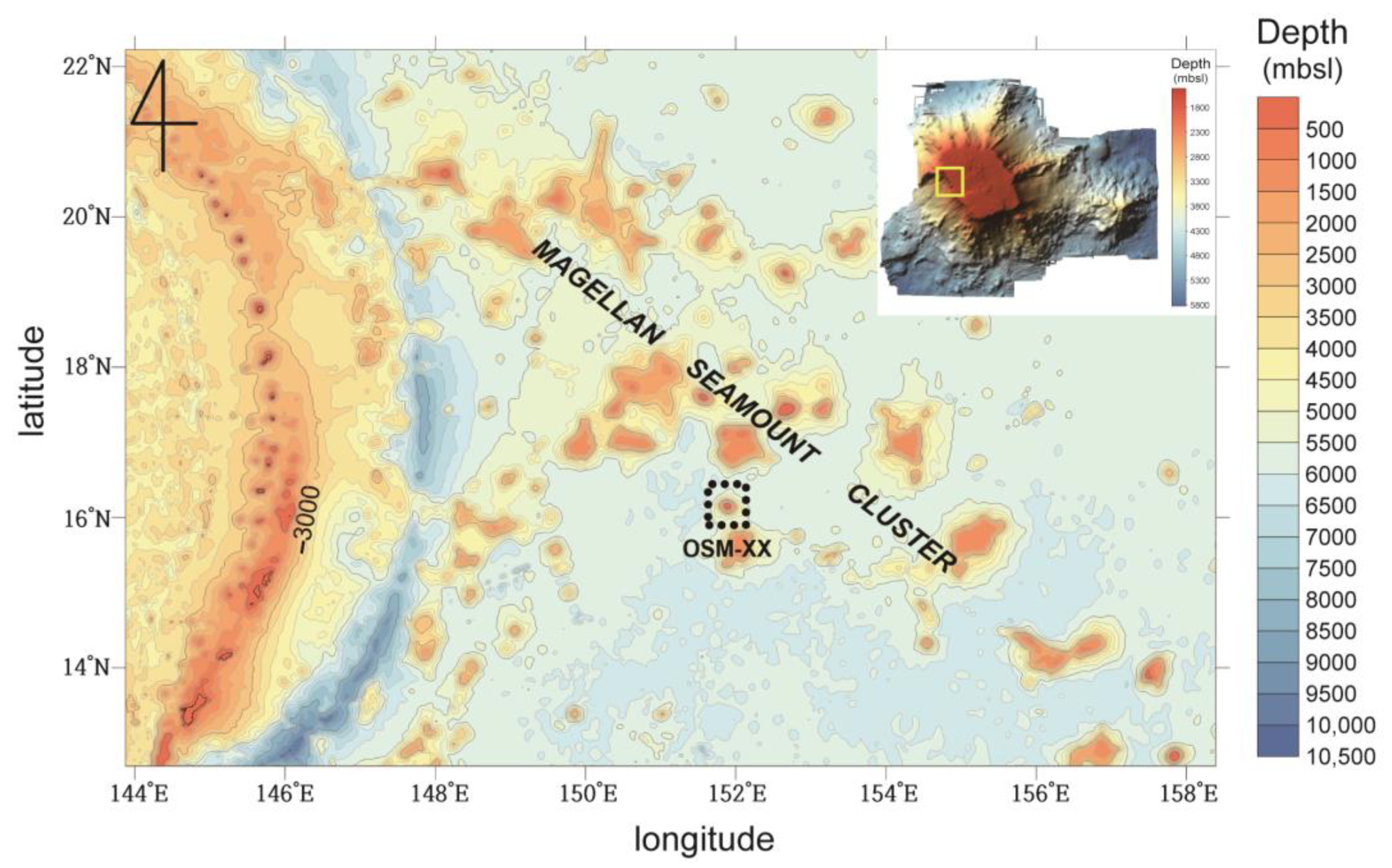


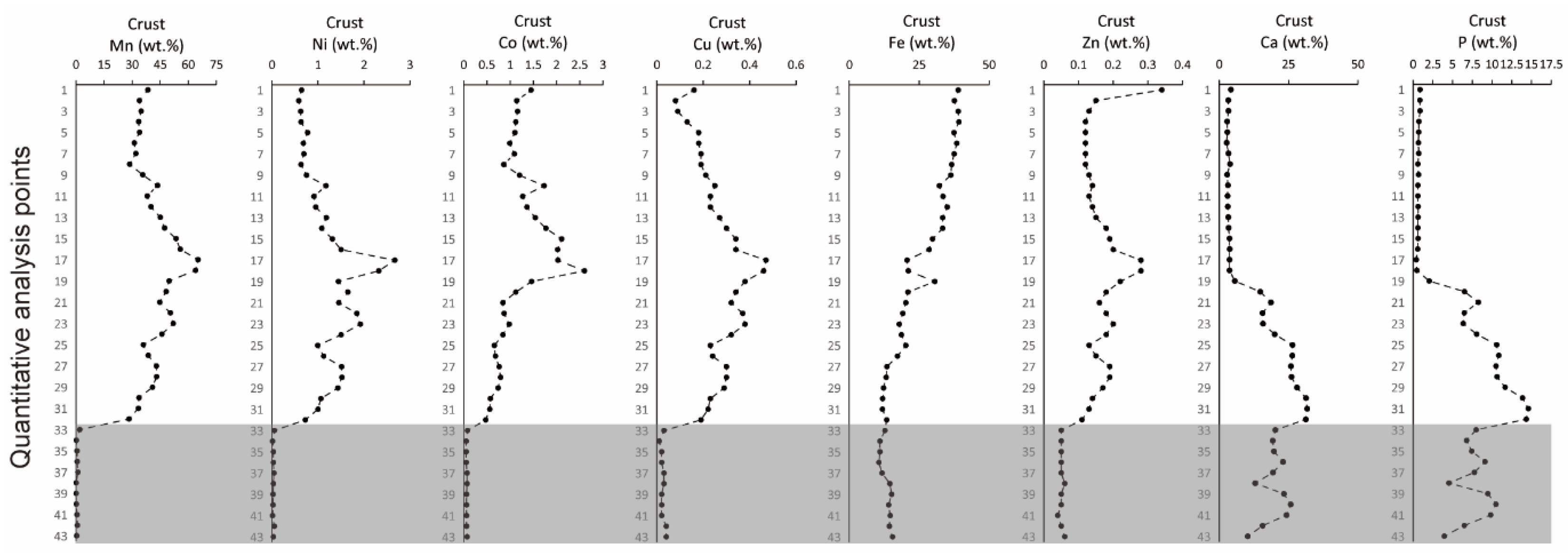
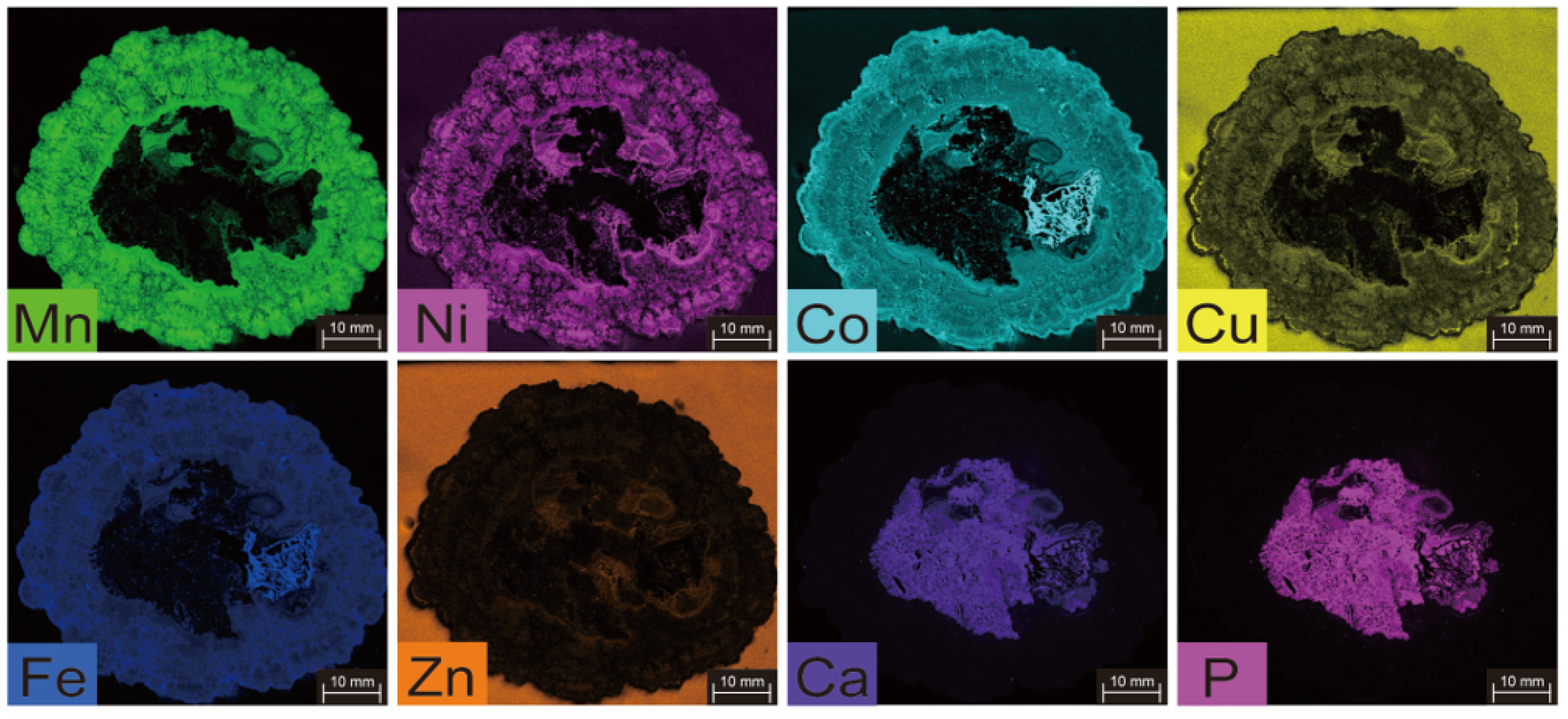


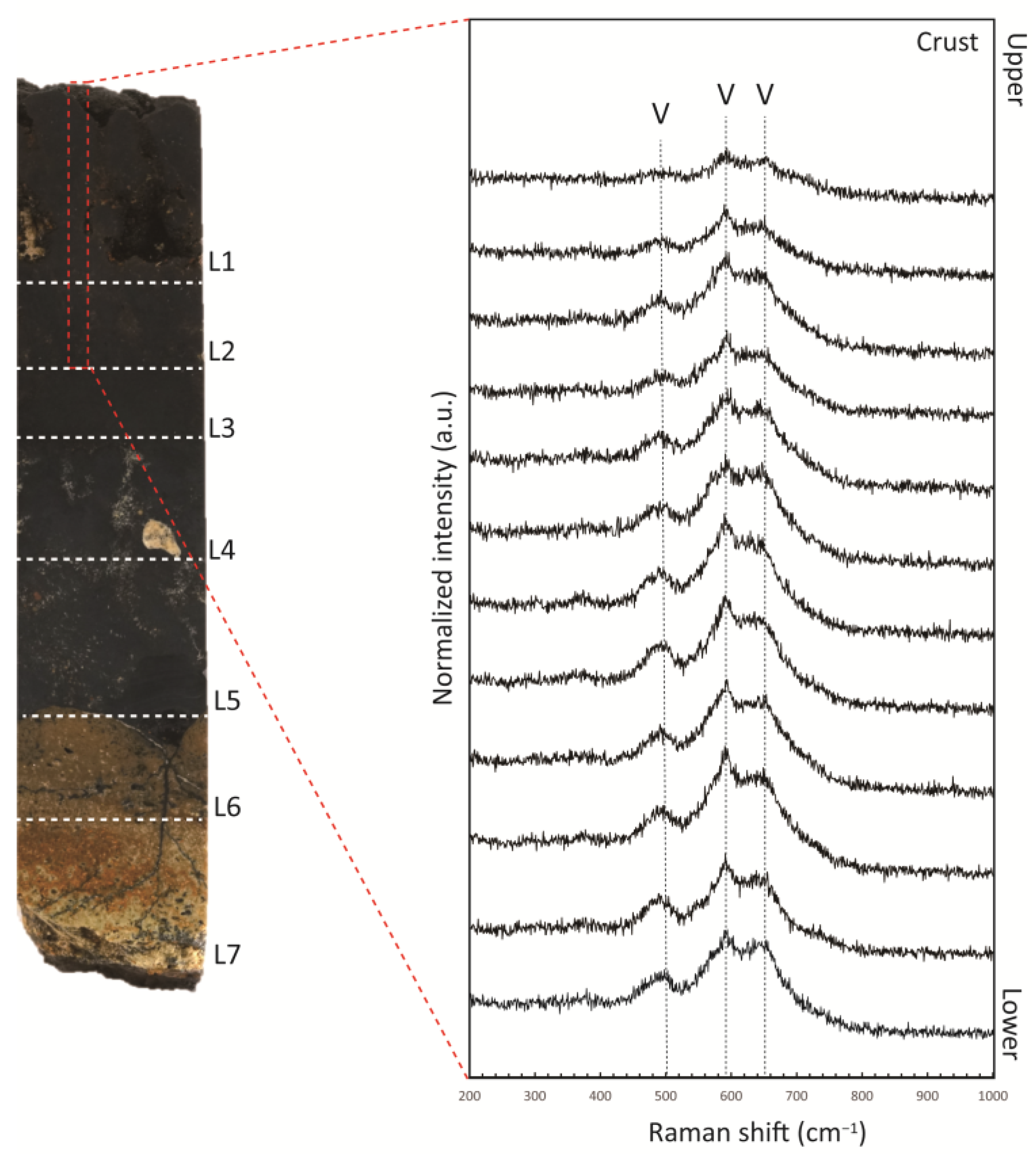

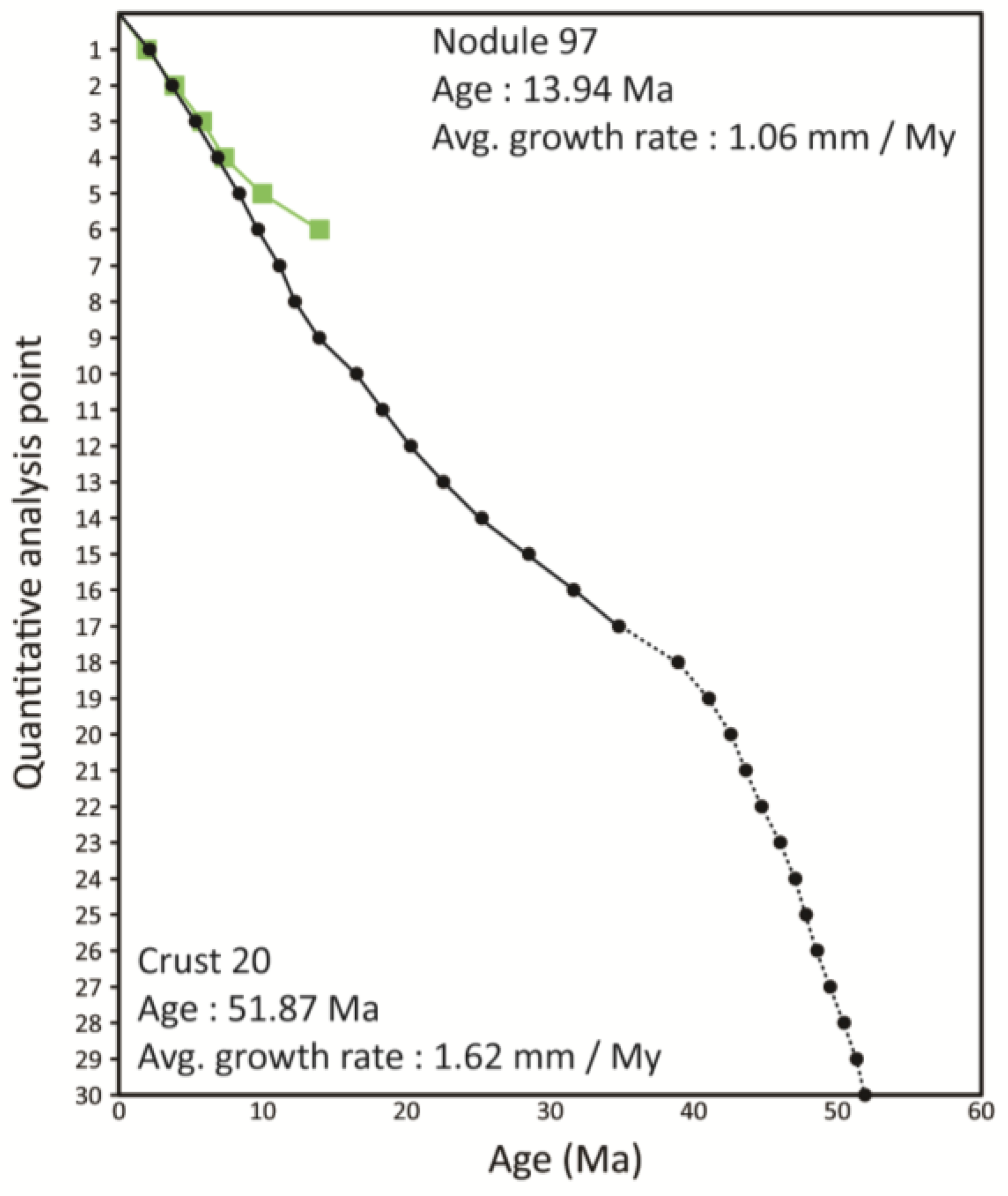



Disclaimer/Publisher’s Note: The statements, opinions and data contained in all publications are solely those of the individual author(s) and contributor(s) and not of MDPI and/or the editor(s). MDPI and/or the editor(s) disclaim responsibility for any injury to people or property resulting from any ideas, methods, instructions or products referred to in the content. |
© 2024 by the authors. Licensee MDPI, Basel, Switzerland. This article is an open access article distributed under the terms and conditions of the Creative Commons Attribution (CC BY) license (https://creativecommons.org/licenses/by/4.0/).
Share and Cite
Park, J.; Hwang, H.; An, H.; Yang, K. High-Resolution Reconstruction of Oxidation–Reduction Conditions: Raman Spectroscopy and μ-XRF Analysis of Manganese Nodule and Crust on Tabletop of Western Pacific Magellan Seamounts. Minerals 2024, 14, 1135. https://doi.org/10.3390/min14111135
Park J, Hwang H, An H, Yang K. High-Resolution Reconstruction of Oxidation–Reduction Conditions: Raman Spectroscopy and μ-XRF Analysis of Manganese Nodule and Crust on Tabletop of Western Pacific Magellan Seamounts. Minerals. 2024; 14(11):1135. https://doi.org/10.3390/min14111135
Chicago/Turabian StylePark, Jinsub, Huijeong Hwang, Hyeonho An, and Kiho Yang. 2024. "High-Resolution Reconstruction of Oxidation–Reduction Conditions: Raman Spectroscopy and μ-XRF Analysis of Manganese Nodule and Crust on Tabletop of Western Pacific Magellan Seamounts" Minerals 14, no. 11: 1135. https://doi.org/10.3390/min14111135
APA StylePark, J., Hwang, H., An, H., & Yang, K. (2024). High-Resolution Reconstruction of Oxidation–Reduction Conditions: Raman Spectroscopy and μ-XRF Analysis of Manganese Nodule and Crust on Tabletop of Western Pacific Magellan Seamounts. Minerals, 14(11), 1135. https://doi.org/10.3390/min14111135







